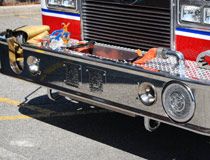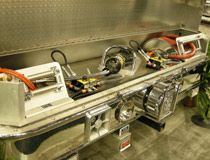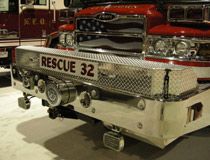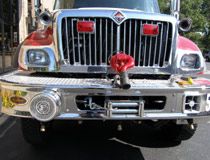 All Photos by Bob Vaccaro Front bumper with trash line, secured in place by velcro hose strap. It also has a bumper cut out for a soft suction hose and spanner wrenches mounted. |
Go to any of the fire service conferences and look at the apparatus that’s on display — maybe eight out of 10 have some type of extended front bumper with added hose lines or tools mounted.
It started more than 30 years ago with extended front bumpers designed to hold the front suction hose in a bumper tray, with the intake located directly in the front of the cab.
With the advent of tilt cabs, the front suction connection was pushed to the right side of the apparatus and made into a swivel mount for easier access when connecting to a hydrant.
Then came mounting extinguishers and forcible entry tools on ladder trucks.
Now just about every conceivable type of tool or hose line is mounted on the front bumper. Do I think this is a good idea? Yes would be my answer. As long as you follow NFPA 1901 and its provisions for mounting tools and hose when you spec out your rig, you won’t have a problem.
 Extended front bumper with 2 hydraulic manifolds for rescue tools as well as a small booster line with nozzle. |
In many cases you can exceed what is required to be carried on an engine, truck or rescue according to NFPA 1901. Just be careful not to exceed the gross vehicle weight.
If you are going to mount trash lines or quick attack lines on the front bumper, for instance, make sure the hose tray is deep enough to hold the amount of hose you want to carry.
Then, also either have a mesh covering or even a hinged diamond plate cover mounted over the hose to safely keep it in place.
You don’t want to have the hose and nozzles bounce out of the tray when responding, causing you to run it over and destroy the equipment or even damage the apparatus.
 Hinged diamond plate cover securely in place covering rescue tools on this Quantum Heavy Rescue. |
This also holds true for extrication tools and hand tools. Most of the new heavy rescues that are out there on the market have hydraulic connections placed on the extended front bumper with manifolds to power several cutting and spreading tools at one time.
It enables responders to get the tools in operation more quickly instead of having to open a compartment door and pull them out.
However, remember that this type of operation may not be for everyone.
For instance, you may need more of a hydraulic line to reach your scene and might not be able to get the front of the heavy rescue close enough to the incident to operate.
Only you and your apparatus committee can decide what is right for your operations.
 Winch, cab-operated nozzle and hose line mounted on urban interface rig. |
Don’t just copy your neighbors’ specs. But, it is worth talking to some of your neighboring departments to see what they like and dislike about how they mounted front bumper tools and hose.
Also, go to some of the fire service conferences and look at the apparatus on display.
As I always say, “Make an educated decision after a well thought out plan, and you can’t go wrong.”











